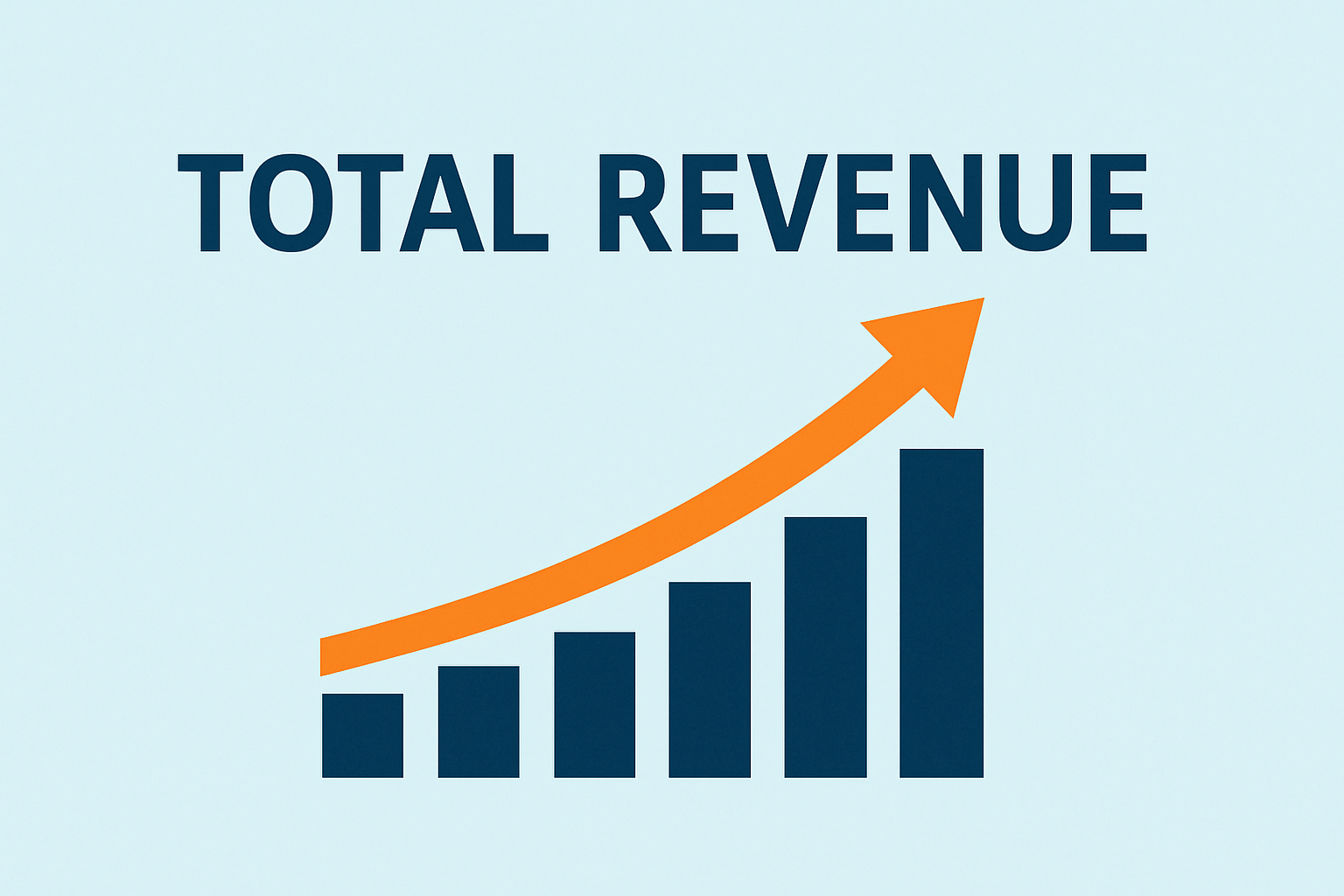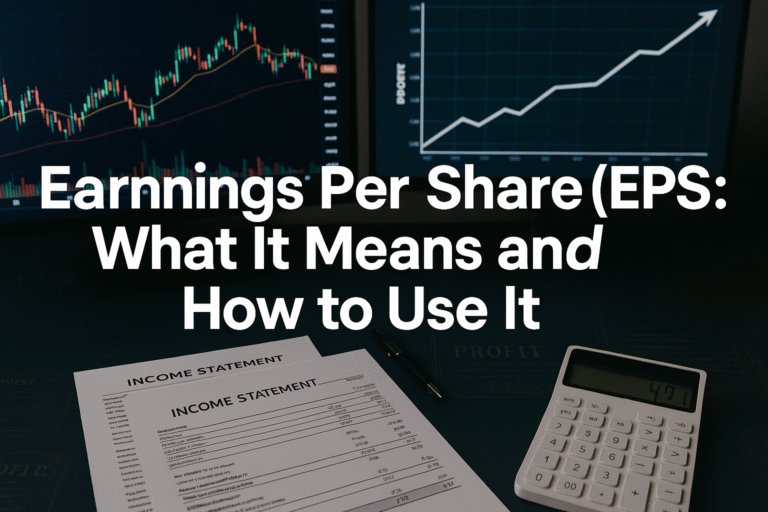Picture this: You’re running a lemonade stand on a hot summer day. Kids are lining up, quarters are clinking into your jar, and by sunset, you’ve sold 100 cups at 50 cents each. That $50 sitting in your jar? That’s your total revenue—the lifeblood of any business, from your neighborhood lemonade stand to Fortune 500 companies. Understanding total revenue isn’t just for accountants and CFOs; it’s a fundamental concept that every investor, entrepreneur, and financially savvy person needs to master. Whether you’re evaluating a company’s stock market performance or planning your own business venture, knowing how to calculate and interpret total revenue is your first step toward making smarter financial decisions.
TL;DR
- Total revenue is the total amount of money a company earns from selling its goods or services before deducting any expenses
- The formula is simple: Total Revenue = Price per Unit × Quantity Sold
- Total revenue helps investors assess a company’s sales performance, market demand, and growth potential
- Unlike profit, total revenue doesn’t account for costs—a company can have high revenue but still lose money
- Tracking total revenue trends over time reveals whether a business is expanding, stagnating, or declining
What Is Total Revenue? A Clear Definition
In simple terms, total revenue means the total amount of money a business receives from its customers for selling products or services during a specific period.
Total revenue (often abbreviated as TR) represents the top line of a company’s income statement; it’s the gross income before any deductions for costs, expenses, or taxes. Think of it as the starting point for understanding a company’s financial health. Whether you’re analyzing a tech startup or a dividend-paying blue-chip stock, total revenue tells you how much money is flowing into the business from its core operations.
Why Total Revenue Matters
Total revenue serves as a critical metric for several reasons:
- Growth indicator: Rising total revenue typically signals increasing market demand and business expansion
- Investment analysis: Investors use revenue growth to evaluate whether a company is gaining or losing market share
- Business planning: Companies rely on revenue projections to make strategic decisions about hiring, expansion, and investment
- Comparative analysis: Revenue figures allow you to compare companies of different sizes within the same industry
- Market valuation: Many valuation multiples (like Price-to-Sales ratio) are based on total revenue
According to the Securities and Exchange Commission (SEC), publicly traded companies must report their revenue figures quarterly and annually, making this data readily accessible to investors and analysts.
The Total Revenue Formula: How to Calculate It
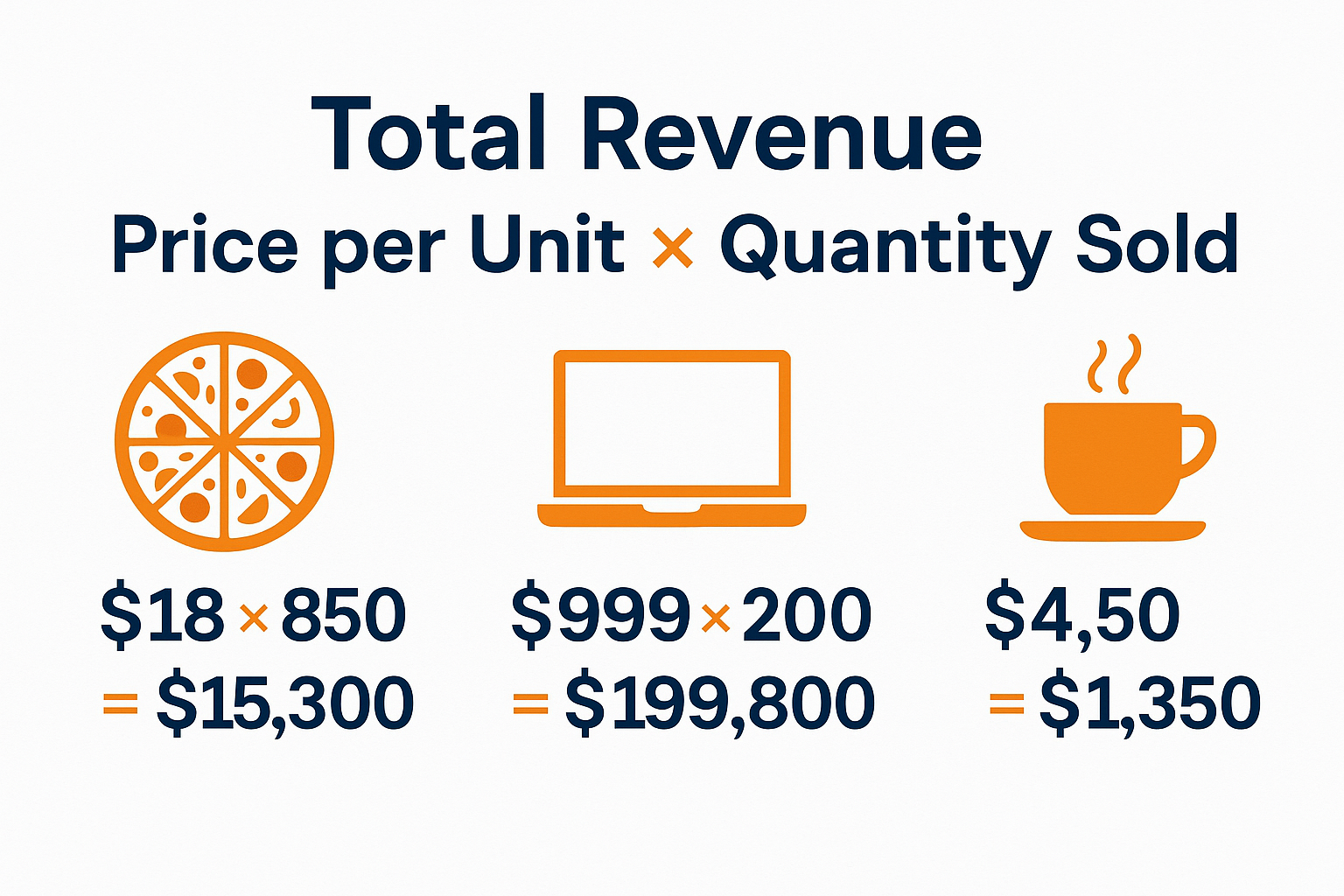
The formula for total revenue is remarkably straightforward:
Total Revenue = Price per Unit × Quantity Sold
Or, expressed mathematically:
TR = P × Q
Where:
- TR = Total Revenue
- P = Price per unit (the selling price of one item or service)
- Q = Quantity (the number of units sold)
Breaking Down the Components
Let’s examine each element of the formula:
Price per Unit (P): This is what customers pay for a single product or service. For example:
- A coffee shop charges $4.50 per latte
- A software company charges $29.99 per month for a subscription
- An automaker sells a car for $35,000
Quantity Sold (Q): This represents the total number of units sold during a specific time period:
- The coffee shop sells 200 lattes per day
- The software company has 5,000 active subscribers
- The automaker sells 10,000 cars per quarter
Multiple Products or Services
For businesses selling multiple products at different prices, the formula expands:
Total Revenue = (P₁ × Q₁) + (P₂ × Q₂) + (P₃ × Q₃) + …
For example, a bakery selling bread, cookies, and cakes would calculate:
- Bread: $5 × 100 loaves = $500
- Cookies: $2 × 150 cookies = $300
- Cakes: $25 × 20 cakes = $500
- Total Revenue = $1,300
Real-World Total Revenue Examples
Let’s walk through several practical examples to solidify your understanding:
Example 1: Simple Single-Product Business
Mario’s Pizza Shop sells large pizzas for $18 each. In January 2025, they sold 850 pizzas.
Calculation:
- Price per Unit (P) = $18
- Quantity Sold (Q) = 850
- Total Revenue = $18 × 850 = $15,300
Mario’s Pizza Shop generated $15,300 in total revenue for January.
Example 2: Service-Based Business
StyleCuts Salon offers three services:
- Haircuts: $40 each (performed 120 times in March)
- Hair coloring: $85 each (performed 45 times in March)
- Styling: $60 each (performed 30 times in March)
Calculation:
- Haircuts: $40 × 120 = $4,800
- Hair coloring: $85 × 45 = $3,825
- Styling: $60 × 30 = $1,800
- Total Revenue = $10,425
Example 3: Subscription-Based Technology Company
CloudStore Inc. offers cloud storage subscriptions at three tiers:
- Basic Plan: $9.99/month (10,000 subscribers)
- Premium Plan: $19.99/month (5,000 subscribers)
- Enterprise Plan: $49.99/month (1,000 subscribers)
Monthly Total Revenue Calculation:
- Basic: $9.99 × 10,000 = $99,900
- Premium: $19.99 × 5,000 = $99,950
- Enterprise: $49.99 × 1,000 = $49,990
- Total Monthly Revenue = $249,840
- Annual Total Revenue = $249,840 × 12 = $2,998,080
Example 4: E-commerce Retailer
TrendyWear Online sells clothing items with varying prices. In Q1 2025:
- T-shirts: $25 each (sold 2,000 units)
- Jeans: $65 each (sold 800 units)
- Jackets: $120 each (sold 300 units)
- Accessories: $15 each (sold 1,500 units)
Calculation:
- T-shirts: $25 × 2,000 = $50,000
- Jeans: $65 × 800 = $52,000
- Jackets: $120 × 300 = $36,000
- Accessories: $15 × 1,500 = $22,500
- Total Revenue for Q1 = $160,500
Total Revenue vs Total Profit: Understanding the Difference
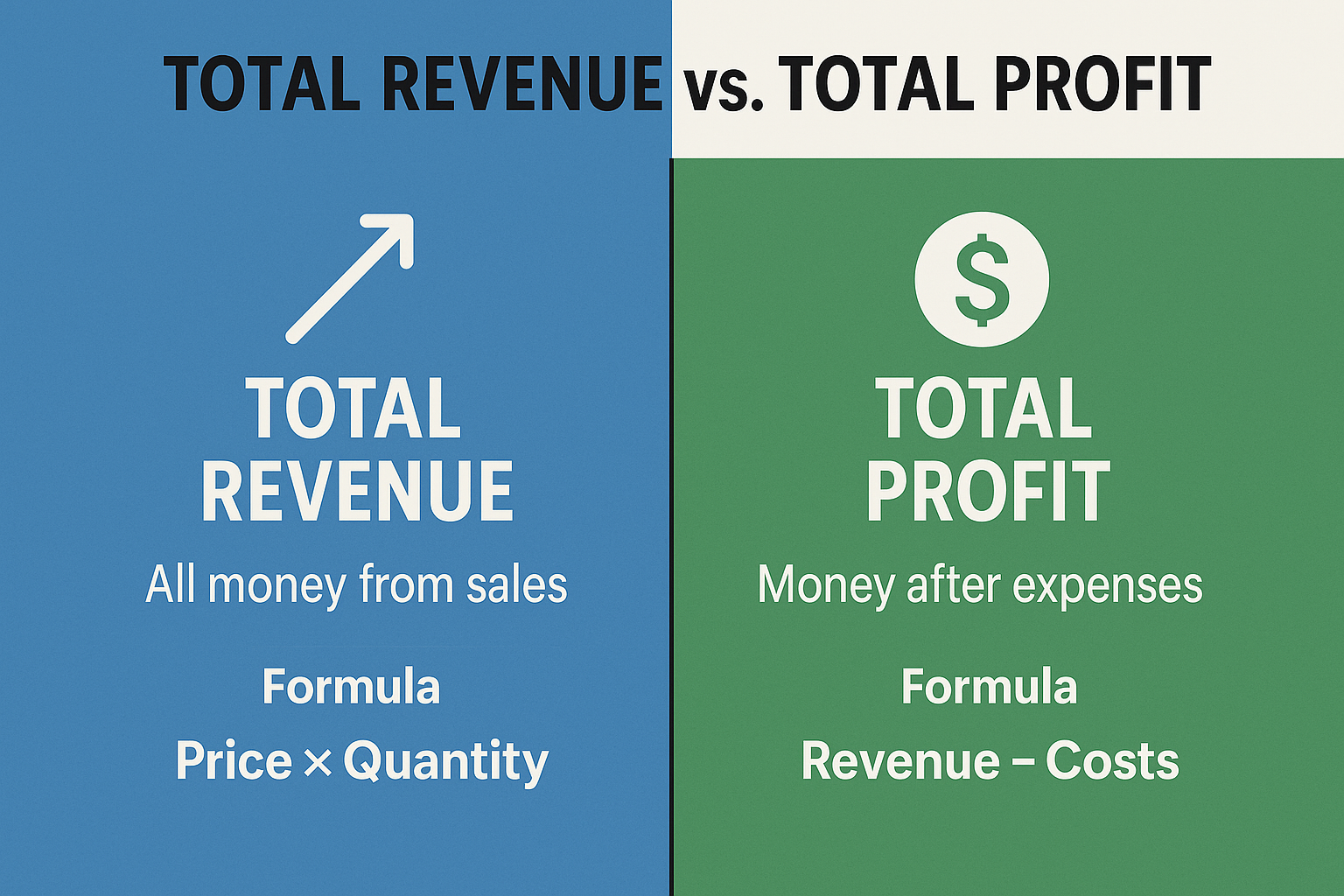
One of the most common mistakes beginners make is confusing total revenue with total profit. These are fundamentally different concepts:
| Aspect | Total Revenue | Total Profit |
|---|---|---|
| Definition | All money received from sales | Money remaining after all expenses |
| Formula | Price × Quantity | Total Revenue – Total Costs |
| Position on Income Statement | Top line (first entry) | Bottom line (final entry) |
| Includes Expenses? | No | Yes |
| Can be negative? | No (minimum is zero) | Yes (indicates losses) |
| Also known as | Gross revenue, sales | Net income, earnings |
Why This Distinction Matters
A company can have high total revenue but low (or negative) profit if its expenses are too high. Consider this example:
TechGadget Inc. – Year 2024:
- Total Revenue: $10,000,000
- Total Costs (manufacturing, salaries, marketing, rent, etc.): $11,000,000
- Total Profit: -$1,000,000 (a loss)
Despite generating $10 million in revenue, TechGadget lost $1 million because their costs exceeded its income. This scenario is common among growth-stage companies that invest heavily in expansion or businesses facing operational inefficiencies.
When evaluating stocks or business opportunities, savvy investors look at both revenue and profit to get the complete picture.
Total Revenue in Different Business Models
Different types of businesses calculate and think about total revenue in unique ways:
1. Retail Businesses
Retail stores generate revenue through direct product sales. Their total revenue equals all items sold multiplied by their respective prices.
Key consideration: Retail businesses often track revenue per square foot to measure store efficiency.
2. Subscription Services
Companies like Netflix, Spotify, or SaaS (Software as a Service) businesses generate recurring revenue through monthly or annual subscriptions.
Key consideration: These businesses focus on metrics like Monthly Recurring Revenue (MRR) and Annual Recurring Revenue (ARR), which are specialized forms of total revenue.
3. Manufacturing Companies
Manufacturers sell products in bulk to distributors, retailers, or directly to consumers.
Key consideration: They often track revenue by product line to identify which products drive the most income.
4. Service Businesses
Consulting firms, law offices, and repair services generate revenue by charging for time, expertise, or completed projects.
Key consideration: Billable hours and service rates directly determine total revenue.
5. E-commerce Platforms
Online marketplaces may generate revenue through:
- Direct product sales
- Commission on third-party sales
- Advertising fees
- Subscription fees for premium features
Key consideration: E-commerce businesses often report Gross Merchandise Value (GMV) alongside total revenue, where GMV represents the total value of all transactions, while revenue might only include the platform’s commission.
How to Interpret Total Revenue: What the Numbers Tell You
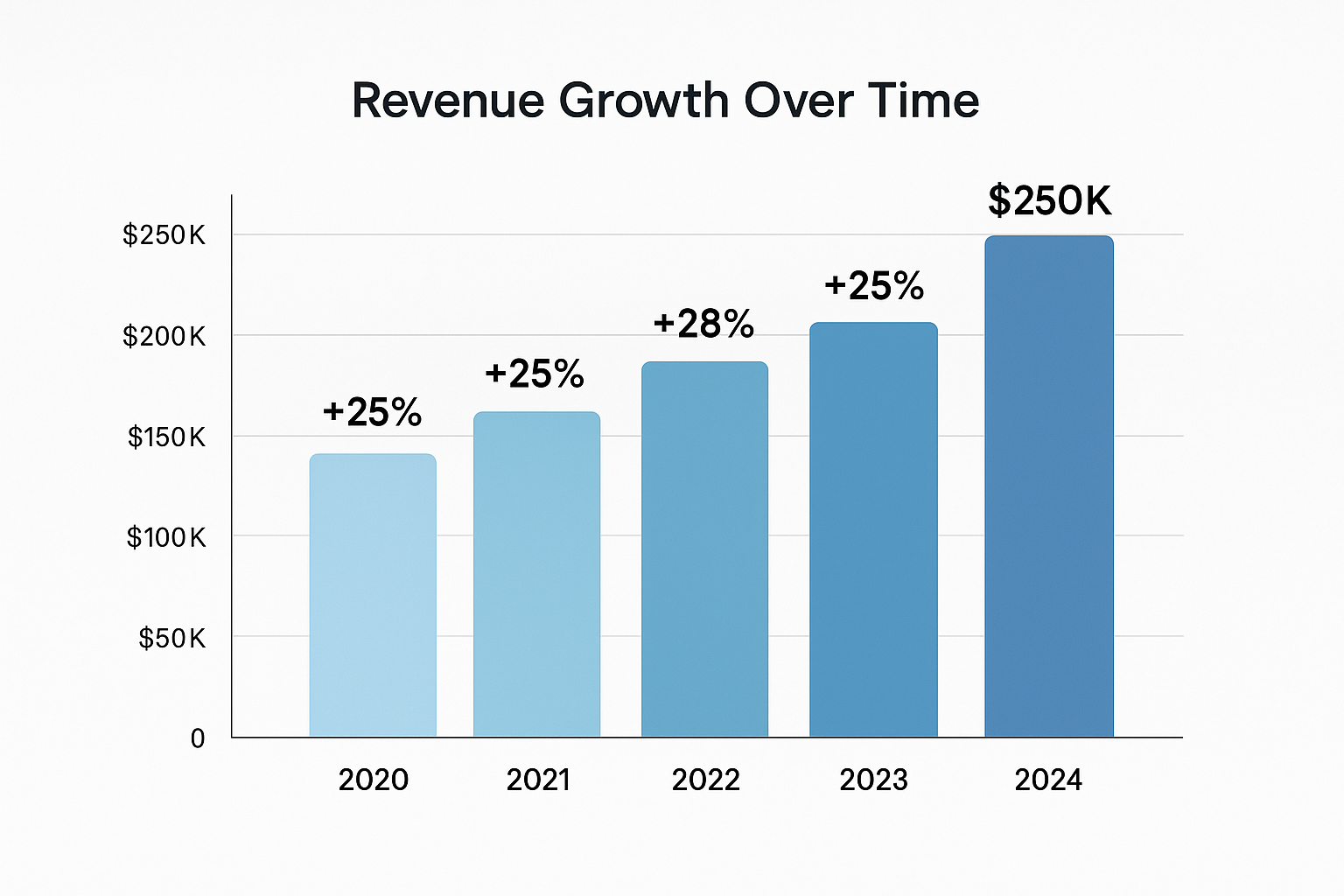
Understanding what total revenue figures mean requires context and comparison:
Revenue Growth Rate
The revenue growth rate shows how quickly a company’s sales are increasing (or decreasing):
Revenue Growth Rate = [(Current Period Revenue – Previous Period Revenue) / Previous Period Revenue] × 100
Example:
- Q1 2024 Revenue: $500,000
- Q1 2025 Revenue: $575,000
- Growth Rate = [($575,000 – $500,000) / $500,000] × 100 = 15%
A 15% year-over-year revenue growth rate indicates healthy expansion. According to research from Morningstar, companies with consistent revenue growth rates above 10% often outperform the broader market.
Industry Benchmarks
Total revenue means different things in different industries:
- Tech startups: Often prioritize rapid revenue growth over profitability in early stages
- Mature retailers: Expect steady, modest revenue growth (2-5% annually)
- High-growth sectors: Companies in emerging industries might see 30-50%+ annual revenue growth
- Declining industries: May experience negative revenue growth despite operational efficiency
Revenue Concentration Risk
If a company generates most of its total revenue from a single customer or product, it faces concentration risk. Investors typically prefer diversified revenue streams.
Red flag example: A software company earning 70% of its total revenue from one client is vulnerable if that client leaves.
Total Revenue and Stock Market Analysis
For investors analyzing potential stock market investments, total revenue serves several important functions:
Price-to-Sales (P/S) Ratio
The Price-to-Sales ratio compares a company’s market capitalization to its total revenue:
P/S Ratio = Market Capitalization / Total Annual Revenue
This valuation metric is handy for:
- Evaluating unprofitable companies (which have no P/E ratio)
- Comparing companies within the same industry
- Identifying potentially undervalued stocks
Example:
- Company market cap: $5 billion
- Annual total revenue: $1 billion
- P/S Ratio = 5
A lower P/S ratio might indicate an undervalued stock, though this varies significantly by industry.
Revenue Quality
Not all revenue is created equal. High-quality revenue has these characteristics:
Recurring: Subscription-based revenue is more predictable than one-time sales
Diversified: Multiple revenue streams reduce risk
Organic: Growth from existing operations rather than acquisitions
Cash-based: Revenue that’s actually collected, not just booked on paper
Revenue Surprises and Stock Prices
When companies report quarterly earnings, what often moves the stock market is whether they beat, meet, or miss revenue expectations. A “revenue miss” (reporting lower revenue than analysts expected) typically causes stock prices to drop, while “beating revenue estimates” often drives prices up.
Common Mistakes When Calculating Total Revenue
Avoid these frequent errors:
Mistake 1: Including Non-Operating Income
Wrong approach: Adding investment income, interest earned, or asset sales to total revenue
Correct approach: Total revenue should only include income from core business operations (selling products or services)
Mistake 2: Confusing Revenue with Cash Received
Wrong approach: Only counting revenue when cash is physically received
Correct approach: Under accrual accounting (used by most businesses), revenue is recognized when earned, not when cash is collected. A company that makes a sale on credit records the revenue immediately, even if payment arrives 30 days later.
Mistake 3: Forgetting Returns and Discounts
Wrong approach: Using gross sales figures without adjustments
Correct approach: Net revenue = Gross revenue – Returns – Allowances – Discounts
Example:
- Gross sales: $100,000
- Returns: $5,000
- Discounts given: $3,000
- Net total revenue: $92,000
Mistake 4: Mixing Time Periods
Wrong approach: Comparing monthly revenue to annual revenue without adjustment
Correct approach: Always compare like periods (month-to-month, quarter-to-quarter, year-to-year) or annualize shorter periods for meaningful comparisons.
How Businesses Use Total Revenue for Strategic Decisions
Companies leverage total revenue data to make informed strategic choices:
Pricing Strategy
By analyzing how price changes affect quantity sold and total revenue, businesses can optimize their pricing:
Scenario A – Price Increase:
- Original: $10 price × 1,000 units = $10,000 revenue
- After 10% increase: $11 price × 900 units = $9,900 revenue
- Result: Revenue decreased; price increase was counterproductive
Scenario B – Price Decrease:
- Original: $10 price × 1,000 units = $10,000 revenue
- After 10% decrease: $9 price × 1,300 units = $11,700 revenue
- Result: Revenue increased; price decrease drove profitable volume growth
Market Expansion Decisions
Companies track total revenue by geographic region, customer segment, or product line to identify growth opportunities:
Example – Regional Revenue Analysis:
| Region | Q4 2024 Revenue | Q4 2025 Revenue | Growth Rate |
|---|---|---|---|
| North America | $2,000,000 | $2,200,000 | +10% |
| Europe | $1,500,000 | $1,800,000 | +20% |
| Asia | $800,000 | $1,200,000 | +50% |
Strategic insight: Asia shows the highest growth rate, suggesting the company should increase investment in that market.
Resource Allocation
Understanding which products or services generate the most total revenue helps businesses allocate resources efficiently:
80/20 Rule Example:
- Product A: 20% of catalog, generates 65% of total revenue → Prioritize inventory and marketing
- Products B-F: 80% of the catalog generates 35% of total revenue → Evaluate whether to discontinue low performers
Total Revenue in Financial Statements
Total revenue appears prominently in financial reporting:
Income Statement Position
The income statement (also called profit and loss statement) always begins with total revenue at the top:
INCOME STATEMENT - ABC Company
Year Ended December 31, 2025
Total Revenue $5,000,000
Cost of Goods Sold ($2,000,000)
___________
Gross Profit $3,000,000
Operating Expenses ($1,800,000)
___________
Operating Income $1,200,000
Interest & Taxes ($300,000)
___________
Net Income (Profit) $900,000SEC Reporting Requirements
According to SEC.gov regulations, publicly traded companies must disclose:
- Quarterly revenue figures (10-Q filings)
- Annual revenue (10-K filings)
- Revenue recognition policies
- Breakdown of revenue by business segment (if applicable)
- Material changes in revenue sources
These requirements ensure transparency for investors making informed investment decisions.
Total Revenue and Economic Indicators
On a broader scale, total revenue aggregated across companies provides economic insights:
GDP Connection
Gross Domestic Product (GDP) is partially calculated using total revenue data from businesses across the economy. Rising aggregate business revenue typically correlates with economic expansion.
Industry Health
The U.S. Federal Reserve and other economic institutions track revenue trends by industry to assess economic health:
- Expanding industries: Show rising total revenue across most companies
- Contracting industries: Display declining revenue trends
- Cyclical industries: Revenue fluctuates with economic cycles
Understanding these patterns helps investors identify opportunities and risks in different sectors.
Advanced Total Revenue Concepts
For those ready to go deeper:
Revenue Recognition Principles
Generally Accepted Accounting Principles (GAAP) and International Financial Reporting Standards (IFRS) provide specific rules about when companies can recognize revenue:
Five-step model (ASC 606):
- Identify the contract with a customer
- Identify the performance obligations
- Determine the transaction price
- Allocate the price to performance obligations
- Recognize revenue when obligations are satisfied
Why this matters: Two companies with identical sales might report different total revenue in the same period based on when they recognize it.
Deferred Revenue
Some businesses receive payment before delivering goods or services. This creates deferred revenue (also called unearned revenue):
Example: A magazine publisher sells annual subscriptions for $120 in January.
- Cash received: $120 (goes to balance sheet as liability)
- Monthly revenue recognized: $10 per month for 12 months
- Total revenue over the year: $120
Revenue Per Employee
Revenue per employee = Total Revenue / Number of Employees
This metric measures productivity and efficiency:
Example:
- Company A: $10 million revenue, 100 employees = $100,000 per employee
- Company B: $10 million revenue, 200 employees = $50,000 per employee
Company A generates more revenue per employee, suggesting higher efficiency. According to CFA Institute research, this metric varies widely by industry, with technology companies often showing the highest revenue per employee.
Total Revenue Optimization Strategies
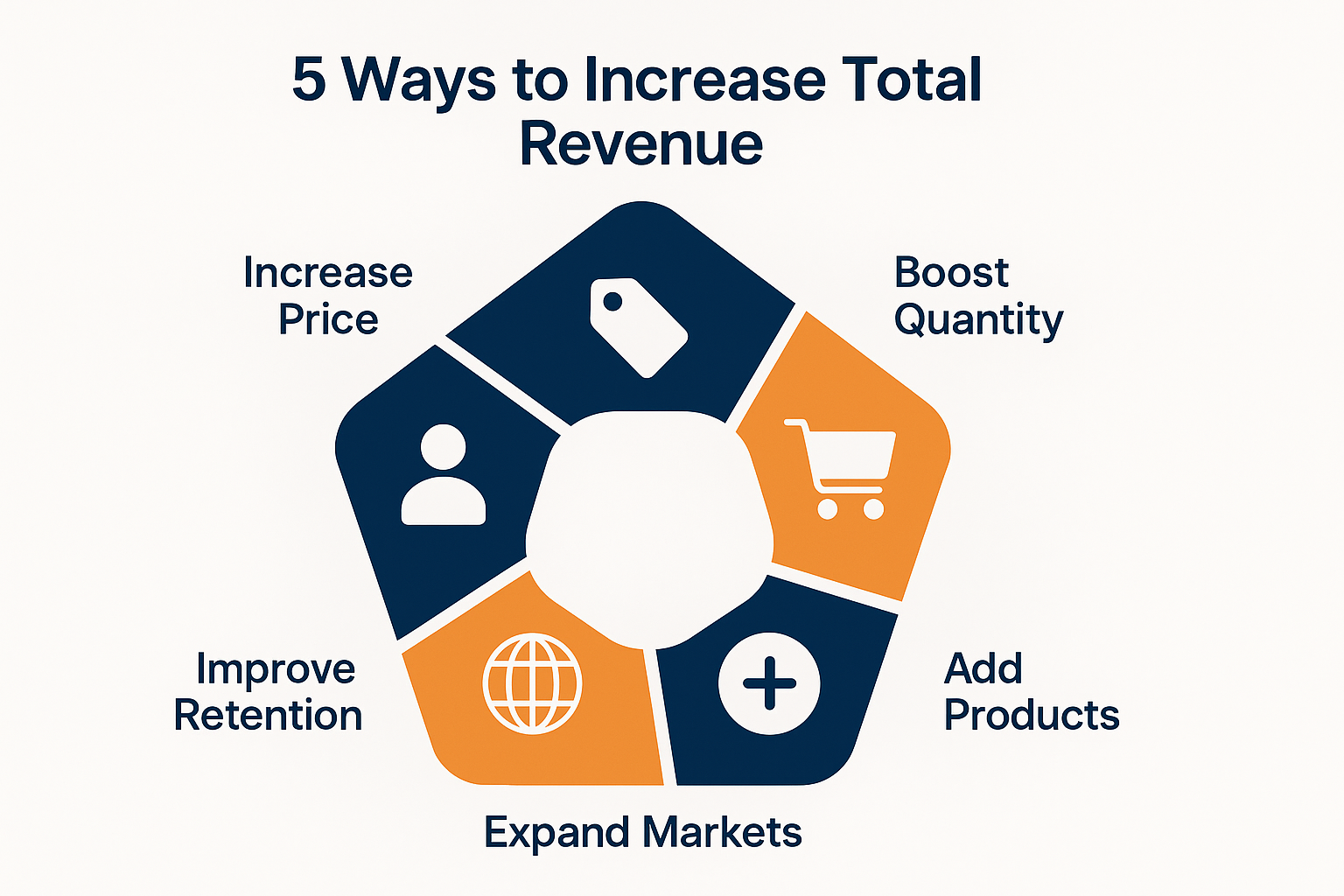
Businesses employ various tactics to increase total revenue:
Strategy 1: Volume Expansion
Increase the quantity sold (Q) while maintaining price (P):
Tactics:
- Expand to new geographic markets
- Increase marketing and advertising
- Improve distribution channels
- Enhance product availability
Strategy 2: Price Optimization
Adjust pricing (P) to maximize total revenue:
Tactics:
- Premium pricing for high-value segments
- Promotional pricing to drive volume
- Dynamic pricing based on demand
- Value-based pricing aligned with customer perception
Strategy 3: Product Mix Enhancement
Shift sales toward higher-priced products:
Example:
- Current mix: 70% low-margin products, 30% high-margin products
- Optimized mix: 50% low-margin products, 50% high-margin products
- Result: Higher average transaction value and total revenue
Strategy 4: Customer Retention
Acquiring new customers costs 5-25 times more than retaining existing ones. Businesses that improve customer retention increase total revenue through:
- Repeat purchases
- Higher lifetime customer value
- Reduced customer acquisition costs
- Positive word-of-mouth marketing
This principle applies equally to dividend investing strategies, where reinvesting dividends compounds returns over time.
Interactive Total Revenue Calculator
💰 Total Revenue Calculator
📊 Formula: Total Revenue = Price per Unit × Quantity Sold
Total Revenue Trends and Economic Cycles
Total revenue doesn't exist in a vacuum—it responds to broader economic conditions:
During Economic Expansion
When the economy is growing:
- Consumer spending increases
- Business investment rises
- Total revenue typically grows across most sectors
- Companies may raise prices without losing customers
During the Economic Recession
When the economy contracts:
- Consumer spending decreases
- Businesses cut back on purchases
- Total revenue often declines or grows more slowly
- Price competition intensifies
Understanding these cycles helps investors anticipate market volatility and adjust their portfolios accordingly.
Defensive vs Cyclical Revenue
Defensive companies (utilities, consumer staples, healthcare) maintain relatively stable total revenue during recessions because people still need electricity, food, and medicine.
Cyclical companies (luxury goods, automotive, travel) experience more volatile total revenue that rises and falls with economic conditions.
Investors seeking passive income through dividend investing often favor defensive companies with stable revenue streams.
Key Risks and Limitations of Total Revenue Analysis
While total revenue is essential, relying on it exclusively has limitations:
Revenue Quality Issues
Not all revenue is equally valuable:
- Low-margin revenue: High revenue with minimal profit contribution
- One-time revenue: Non-recurring sales that inflate current period results
- Channel stuffing: Artificially inflating revenue by pushing excess inventory to distributors
- Revenue recognition manipulation: Aggressive accounting that recognizes revenue prematurely
Ignores Profitability
A company can have impressive total revenue while losing money on every sale. Always examine total revenue alongside:
- Gross profit margin
- Operating profit margin
- Net profit margin
- Free cash flow
Doesn't Reflect Cash Flow
Revenue recognition (especially under accrual accounting) doesn't always align with cash collection. A company might report strong revenue but face cash flow problems if customers pay slowly or default on payments.
Critical insight: The cash conversion cycle measures how quickly revenue converts to actual cash—a vital metric often overlooked by beginners.
Industry-Specific Challenges
Some industries have unique revenue characteristics that complicate analysis:
- Construction: Long-term contracts with revenue recognized over multiple years
- Software: Shifting from perpetual licenses (one-time revenue) to subscriptions (recurring revenue)
- Pharmaceuticals: Revenue concentration in a few blockbuster drugs with patent expiration risks
Total Revenue Best Practices for Investors
When analyzing companies using total revenue data:
✅ Compare Apples to Apples
Always compare companies within the same industry and of similar size. A $10 million revenue tech startup and a $10 billion revenue pharmaceutical giant operate in completely different contexts.
Look at Multi-Year Trends
Don't base decisions on a single quarter or year. Examine 3-5 year revenue trends to identify consistent patterns versus anomalies.
Read the Fine Print
Company financial statements include notes explaining:
- Revenue recognition policies
- Significant customer concentrations
- Segment breakdowns
- Changes in accounting methods
These details provide crucial context that raw revenue numbers alone can't convey.
Consider Revenue Quality
Ask critical questions:
- Is revenue growing organically or through acquisitions?
- What percentage is recurring vs. one-time?
- Are growth rates sustainable?
- How does revenue growth compare to industry peers?
Combine with Other Metrics
Build a comprehensive analysis using total revenue alongside:
- Profitability metrics: Gross margin, operating margin, net margin
- Efficiency metrics: Revenue per employee, asset turnover
- Growth metrics: Revenue CAGR (Compound Annual Growth Rate)
- Valuation metrics: P/S ratio, EV/Revenue
This holistic approach provides a much clearer picture than total revenue alone. For broader investment strategies, explore smart ways to make passive income that complement traditional stock analysis.
Real Data Example: Analyzing Apple Inc.'s Total Revenue
Let's examine a real-world example using publicly available data:
Apple Inc. - Annual Total Revenue (2020-2024)
| Fiscal Year | Total Revenue | Year-over-Year Growth |
|---|---|---|
| 2020 | $274.5 billion | +5.5% |
| 2021 | $365.8 billion | +33.3% |
| 2022 | $394.3 billion | +7.8% |
| 2023 | $383.3 billion | -2.8% |
| 2024 | $391.0 billion | +2.0% |
Source: Apple Inc. SEC 10-K filings
Analysis Insights:
- 2021 Spike: The 33.3% revenue growth reflected pandemic-driven demand for technology products and the successful launch of 5G iPhones
- 2023 Decline: The -2.8% revenue decrease marked a rare contraction, driven by:
- Macroeconomic headwinds
- Supply chain challenges
- Weakening consumer demand in China
- Revenue Composition: Apple's total revenue comes from:
- Products (iPhone, Mac, iPad, Wearables): ~80%
- Services (App Store, iCloud, Apple Music): ~20%
- Strategic Shift: The growing services component (recurring revenue) provides more stability and higher profit margins than hardware sales
This example demonstrates why investors should analyze total revenue trends, composition, and context rather than focusing on a single number. Understanding why the stock market goes up over time requires this kind of fundamental analysis.
Conclusion: Mastering Total Revenue for Financial Success
Total revenue stands as one of the most fundamental concepts in business and investing—a simple yet powerful metric that reveals how much money flows into a company from its core operations. Whether you're evaluating potential stock investments, analyzing business performance, or planning your own entrepreneurial venture, understanding total revenue provides essential insights into financial health and growth potential.
Remember these key principles:
Total revenue = Price per Unit × Quantity Sold is the foundation for all revenue calculations
Revenue is not profit—always examine both the top line (revenue) and bottom line (profit) to get the complete picture
Context matters—compare revenue growth rates to industry benchmarks, historical trends, and competitive positioning
Quality over quantity—recurring, diversified, high-margin revenue is more valuable than one-time, concentrated, low-margin sales
Combine metrics—use total revenue alongside profitability, cash flow, and efficiency measures for comprehensive analysis
Your Next Steps
Now that you understand total revenue, put this knowledge into action:
- Practice calculating: Use the interactive calculator above to experiment with different price and quantity scenarios
- Analyze real companies: Review SEC filings for companies you're interested in and track their revenue trends
- Compare competitors: Examine how different companies in the same industry generate and grow revenue
- Build your investment knowledge: Explore related concepts like profit margins, cash flow, and valuation ratios
- Stay informed: Follow quarterly earnings reports to see how companies perform against revenue expectations
For those interested in building wealth through the stock market, understanding total revenue is just the beginning. Dive deeper into smart investment moves and explore comprehensive resources on the stock market to continue your financial education journey.
The path to financial literacy starts with mastering fundamentals like total revenue. Armed with this knowledge, you're better equipped to make informed decisions about investments, business opportunities, and your financial future. Keep learning, stay curious, and remember that every successful investor started exactly where you are now—with a commitment to understanding the numbers that drive business success.
FAQ: Total Revenue
A "good" total revenue growth rate depends on the company's stage and industry. Mature companies in stable industries might target 3-7% annual growth, while high-growth tech companies might aim for 20-50%+ growth. According to Investopedia, the S&P 500's average revenue growth rate historically ranges from 5-7% annually. Compare a company's growth rate to its industry peers and historical performance for meaningful context.
For service businesses, total revenue equals the sum of all fees charged for services rendered during a specific period. The formula is: TR = (Service Rate × Hours Billed) or (Number of Services × Price per Service). For example, a consulting firm charging $200/hour that billed 1,000 hours in a month generates $200,000 in total revenue.
No, total revenue cannot be negative—the minimum value is zero. If a company has no sales, total revenue equals $0. However, net revenue (total revenue minus returns and allowances) could theoretically approach zero if returns are extremely high, and profit can definitely be negative if costs exceed revenue.
Gross revenue is the total amount received from all sales before any deductions. Net revenue is gross revenue minus returns, allowances, and discounts. For example, if a company has $1,000,000 in gross sales but $50,000 in returns and $30,000 in discounts, net revenue is $920,000. Most financial analyses use net revenue as the starting point.
Total revenue affects stock prices through investor expectations and valuation multiples. When a company reports higher-than-expected revenue, stock prices typically rise as investors anticipate future growth. Revenue misses often trigger price declines. Additionally, revenue growth influences valuation metrics like the Price-to-Sales ratio, which investors use to assess whether a stock is fairly valued.
Companies can maintain profitability despite declining revenue by cutting costs, improving operational efficiency, or exiting unprofitable business segments. For example, a company might close underperforming stores (reducing revenue) while simultaneously cutting overhead costs by a larger amount (increasing profit margins). However, sustained revenue decline often signals long-term challenges.
Market share = (Company's Total Revenue / Total Industry Revenue) × 100. Companies with growing total revenue faster than the overall industry are gaining market share, while those growing more slowly are losing market share. Investors favor companies that consistently gain market share, as this indicates competitive advantages and strong market positioning.
Disclaimer
This article is for educational purposes only and does not constitute financial advice. Total revenue analysis should be one component of a comprehensive investment strategy. Always conduct thorough research and consider consulting with a qualified financial advisor before making investment decisions. Past performance does not guarantee future results.
About the Author
Written by Max Fonji — with a decade of experience in financial education and analysis, your go-to source for clear, data-backed investing education at TheRichGuyMath.com.

